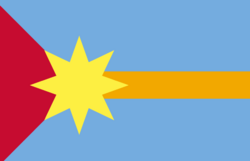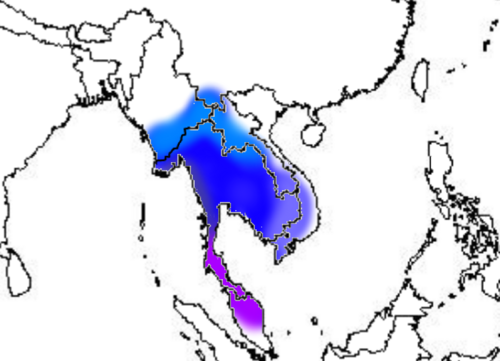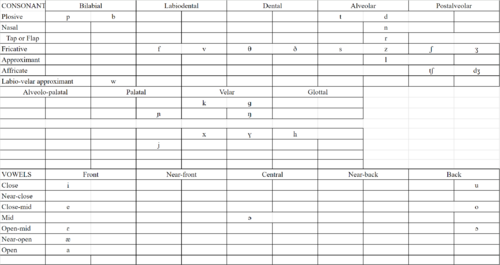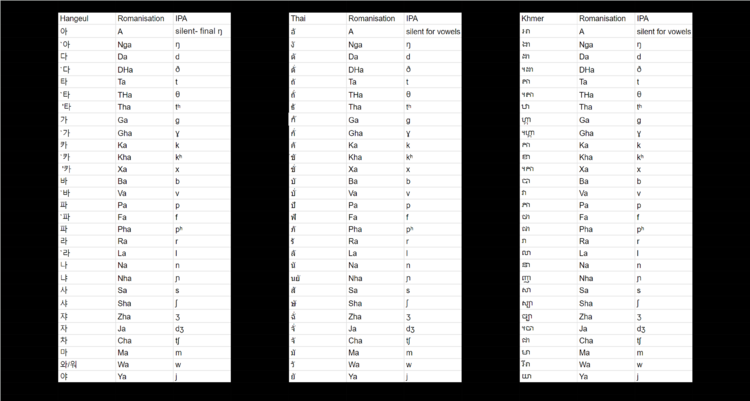Anchwa
| Anchwa | |
|---|---|
 Flag of the Anchwanese Republic | |
| Pronunciation | [anʧwa] |
| Created by | camrionr_ |
| Date | 2023 |
| Setting | Alternate Version of Earth |
| Native to | Republic Of Anchwa (Thailand, Cambodia and most of the Malay peninsula) |
| Ethnicity | Tai-Khmer people |
| Native speakers | Around 100 million (2024) |
Austro-Asiatic
| |
Early forms | Proto-Austro-Asiatic
|
Standard form | Central Anchwa |
Dialects |
|
| Hangeul, Thai, Khmer Scripts | |
| Official status | |
Official language in | Republic of Anchwa |
Recognised minority language in | Laos, Vietnam, Myanmar |
| Regulated by | Department of Anchwanese Language |
Overview
Anchwa is a language spoken in Southeast Asia and West Indochina. It is recognized as the National Language of the Republic of Anchwa. It has two forms, Old Anchwa (or Anchwa rae mai),and modern Anchwa (Anchwa khô mai)It is a historically tonal language that has since lost its tones. Some dialects in the north and east may still remain tonal. Anchwa has a surprisingly high amount of loans from Chinese, Korean, Japanese, and Arabic. Less surprisingly, it has loans from Vietnamese, Khmer and Thai. Malay and Indonesian words have trickled in, but mostly have stayed away from the northern dialects. Malay and Indonesian loans make up about 7% of the Central dialect's words, however, in the Peninsula's dialect, they make up almost 30 percent of the whole vocabulary.
Dialects and Language Map
Anchwa is the national language of the Republic of Anchwa, however, it is a lingua franca of the surrounding area and dialects of it can be found from the Indian sea's shores to the Gulf of Tonkin. It's dialects have a wide variety of influence, however the standard dialect's influences are mostly Chinese, Vietnamese. Thai, Cantonese, Hindi, and Arabic. Smaller influences are Malay and Indonesian, Japanese, Korean, Dutch and German, Spanish and Portuguese, and English. Anchwa's dialects are very diverse. Some have tones, some retain pieces of Anchwa's archaic grammar structure, and others retain old phonemes, such as t͡s. This is the language map of Anchwa:
The colors reflect the dialects: The navy is Central/Standard Anchwa, the light blue is Northern Anchwa, the dark navy is Western Anchwa, the periwinkle is Eastern Anchwa, and finally the purple is Southern Anchwa.
Phonology
Anchwa's Phonology is quite simple. Possibly the strangest additions are the dental fricatives, which are not found anywhere else in their region. Romanization note: the vowel ɔ is represented by ô. If not applicable on individual keyboards, it may also be romanized as aw or au.
Scripts
Anchwa is traditionally written with the Thai or Khmer Scripts, however, 200 years ago, a reform was made to completely switch to the Korean Script for standardization. In communities of ethnic or religious minorities, such as Muslims for example, Anchwa may be written in the Arabic script. For aspirated consonants, an acute apostrophe is added before: '타, for example is "tha". To represent the sounds not present in Hangeul (f, v, dental fricatives, x, gh, and ng), you simply add a grave apostrophe: `다 is the voiced dental fricative, ð. The word for music is nhathei, written as 냐`데이. The Thai script, however, has its own letters for aspirated consonants. What was the low tone mark is the letter used to denote orthography extensions. (like thô thung with the mark turning into θ)And finally, in the Khmer Script, these additions are written with the period: ។. Although legal texts are written in Korean, only the main Bangkok dialects use it. Over 87% of the people in a 2015 poll reported using the Thai or Khmer Script when texting/writing. 98% of people polled could read and write with the Korean script, as it is taught in schools.
The earliest known script in use here was the Chin Kwok script. This was simply Chinese characters, or Hànzì. Similar to it's sister language, Vietnamese, this script became too difficult to keep track of. Thus, like the Chữ Han Việt and Chữ Nôm Scripts, it was quickly dropped. Some time after, the Thai script was picked up, and the story kind of remains the same from there on out.
Grammar
Anchwan Grammar is quite simple. Like other languages in the area, it has no conjugations, and as a whole, inflections are hard to find. This is a complete 180 from Old Anchwa, which had grammar that could make a Hungarian cry. The basic sentence structure is SVO, like other languages in the surrounding area also are. Tenses are added through use of auxiliary words. For the continuous tense, you add daeng/댕.This term is likely a cognate of the Vietnamese đang. Past tense is expressed through the word rieng/리엥.Future tense uses the word tai/타이. One final verb addition is added: the Korean 고 싶어.(ko shipô) This is a word that adds the meaning of "I want to" to the verb. The word for this is 러 `니엥. (Rô ngieng)
Tones
Anchwa is toneless, but its archaic form was. It had 4 tones originally (not including toneless words). High (Ā), Rising(Á), Falling(À), and Low(Ạ). At some point between the 6th and 4th centuries, BCE, the rising and falling tones split from 2 to four: Dipping(Ǎ), Rising, Jumping(Â), and Falling. In terms of registers, Rising was a low to high contour, and falling was a high to low contour. However these new tones added a second contour. For the dipping tone, it went from high to low to high (or a falling-rising tone), and for jumping, it went from low to high to low.(a rising-falling tone.) However, by the time the Arabs arrived in the 2nd century, CE, the amount of tones had receded to two: High and Low. These tones finally disappeared from the central dialect in the 8th century, shortly followed by the grammar reform in the late 900s.
Grammar Reform
By the year 1400, the grammar of Anchwa had been brutally eroded down to that of a language like Spanish. And when Dutch sailors arrived in the 1700's, they described the language's grammar as "Easier than Korean." And when the Korean script was standardized in the 1800's, the grammar structure was almost the same as how it is now. It is written in texts and on statues that "the greatest scholars in the nation traveled across the lands to find the best grammar to suit the language. Whichever was thought to be best would be standardized among government texts and taught in schools. These scholars traveled across the globe to learn different languages and bring back their knowledge. The grammar structure that was decided on was Vietnamese's grammar structure. The scholar who suggested it, Phôram Shiranuk, has this statue in the capital city of Bangkok.", That was written on Shiranuk's statue, which does actually remain to this day.


